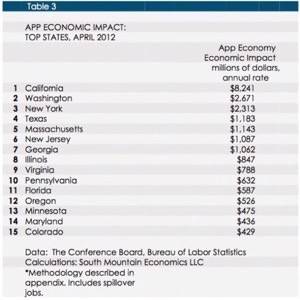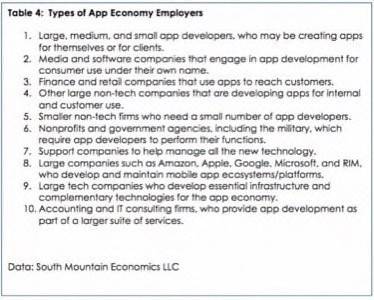The U.S. has lost 4.3 million nonfarm jobs since 2009, but job growth has taken off in some surprising areas. Take app development. That seemingly constrained industry is having an outsized – and positive – impact on regions throughout the country.
A new study by the CTIA — The Wireless Association and the Application Developer’s Alliance shows the mobile industry’s regional impact. Specifically, the development, deployment and support of mobile apps.
The report, “The Geography of the App Economy,” states that, as of April, 519,000 new jobs have been created in the U.S. since 2007, when the iPhone was released, related to mobile app development. Those jobs are worth billions of dollars, creating value for tech communities in almost every state.
For instance, there are about 21,400 app jobs in Massachusetts, mostly centered on Boston and the Route 128 Corridor. Those jobs have a $1.143 billion annual economic impact, according to the report.
California, of course, has the greatest stake in the app economy, with 151,900 related jobs worth $8.241 billion in economic impact. California, home of Google, Apple, Facebook and countless startups, has an app economy four times larger than the No. 2 state, Washington, home of Amazon and Microsoft. See the chart below.

The report breaks jobs in this sector into three categories.
- Core: IT-related jobs that require the ability to develop, maintain, or support mobile applications.
- Indirect: Non-IT jobs that support app developers in the same company.
- Spillover: Jobs in the local economy that are supported by app developers.
The app economy touches on virtually all industries, and is not confined to startups, tech giants or upstart app-dev shops.
Take Zynga, a pure app-economy company with 2,800 employees. But media companies like ESPN are also looking for app developers. And financial giants like Capital One, and retailers like WalMart. The list goes on: Pharmaceutical companies, non-profits, military.

The top 10 states in “app intensity” (app economy jobs compared to the workforce at large) also earn more college degrees, according to the report. An average of 32.3% of adults over age 25 have a college degree in the top 10 states. The bottom 10 average 23.5%.
The study was performed by analyzing help-wanted ads that listed required skills and knowledge. Want ads were scoured with a variety of keywords including iPhone, Android, Windows Phone and BlackBerry. The research was performed by South Mountain Economics based on a sample of 500 app economy jobs and mapped on a state level. Data from the Bureau Of Labor Statistics Occupational Employment Survey from May 2011 was used to estimate wages and determine economic impact. See the chart of methodology below for the fuller context of how the report was generated.

Of course, the CTIA and the Application Developers Alliance have a vested interest in making their industry look like an engine of growth. Consequently, the report should be taken for what it is, a loose guide to how app development has created jobs. There is no doubt that the mobile industry has created a new sector of economic market growth in the United States that did not exist 10 years ago. At the same time, the mobile industry is not a completely new segment but rather an evolution of the digital economy created with the advent of the Internet, Web and advanced telecommunication technologies.
Companies like Apple and Google have created billions of dollars in economic growth because of their advancement of mobile technologies and an industry has popped up around that, specifically aligned to application development (replete with marketers, advertisers, human resources, and so on).
I have estimated that the annual revenue created by Apple App Store and the Android Google Play markets will be between $8-$10 billion (from sales, in-app purchases and advertising). The app industry has doubled in gross revenue nearly every year since 2009 which gives some credence to the aggregate numbers that CTIA reports of economic impact from 2007 on.
Charts courtesy of CTIA and the Application Developers Alliance









